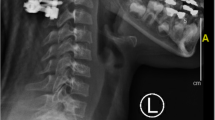Abstract
Introduction
Grisel’s syndrome (GS) is a rare otolaryngologic condition that involves rotatory subluxation of the atlanto-axial joint in the absence of trauma. Sir Charles Bell was the first to describe this condition in 1830. However, it was named after Pierre Grisel, a French ENT specialist who in 1930 described three such cases in children.
Methods
Using standard search engines, we reviewed the most recent literature regarding GS with special attention to its pathogenesis, natural history, and recent treatment options.
Results
Although defined over 80 years ago, the exact pathogenesis leading to GS is still not completely understood. Nevertheless, it occurs mainly as a complication of upper respiratory tract infections and/or surgical interventions in the head and neck. Most recent studies postulate that the spread of septic emboli from such infection nidus via the pharyngovertebral veins to the periodontoid vascular plexus could be the most likely cause. The diagnosis of GS is made by both clinical assessment as well as radiologic confirmation with either CT scan or MRI. Our review found out that most authors favor immobilization with a soft collar and antibiotics over surgical correction in the initial management of GS. Surgery is reserved for severe and refractory cases.
Conclusion
GS remains a rare, but potentially lethal children condition. Early diagnosis and treatment is crucial to its management and prognosis.



Similar content being viewed by others
References
Battiata A, Pazos G (2004) Grisel’s syndrome: the two-hit hypothesis—a case report and literature review. Ear Nose Throat J 83:553–555
Bell C, McKay C (1830) The nervous system of the human body embracing papers delivered to the Royal Society on the subject of the nerves. Longman, Rees, and Orme, London
Cekinmez M, Tufan K, Sen O, Caner H (2009) Non-traumatic atlanto-axial subluxation: Grisel’s syndrome. Two case report. Neurol Med Chir 49:172–174
Chute DJ, Reiber K (2008) Three unusual neuropathologic-related causes of sudden death. J Forensic Sci 53:734–738
Dagtekin A, Kara E, Vayisoglu Y, Koseoglu A, Avci E, Talas D, Bagdatoglu C (2011) The importance of early diagnosis and appropriate treatment in Grisel’s syndrome: report of two cases. Turk Neurosurg 21:680–684
Deichmueller C, Welkoborsky HJ (2010) Grisel’s syndrome—a rare complication following “small” operations and infections in the ENT region. Eur Arch Otorhinolaryngol 267:1467–1473
Derkay C, Kenna M, Pang D (1987) Refractory torticollis: an uncommon complication of adenotonsillectomy. Int J Pediatr Otorhinolaryngol 14:87–93
Durst F, Staudenmaier R, Pilge H, Lauen J, Prodinger P, Holzapfel K, Pickhard A (2011) Grisel-Syndrom nach Anthelixplastik. HNO: 1–4
Galer C, Holbrook E, Treves J, Leopold D (2005) Grisel’s syndrome: a case report and review of the literature. Int J Pediatric Otorhinolaryngol 69:1689–1692
Gourin C, Kaper B, Abdu W, Donegan J (2002) Nontraumatic atlanto-axial subluxation after retropharyngeal cellulitis: Grisel’s syndrome. Am J Otolaryngol 23:60–65
Grisel P (1930) Enucleation de l'atlas et torticollis nasopharyngien. Presse Med 38:50–53
Grobman L, Stricker S (1990) Grisel’s syndrome. Ear Nose Throat J 69:799–801
Harth M, Mayer M, Marzi I, Vogl TJ (2004) Lateral torticollis on plain radiographs and MRI: Grisel syndrome. Eur Radiol 14:1713–1715
Jackson H (1950) The diagnosis of minimal atlanto-axial subluxation. Br J Radiol 23:672–674
Karkos PD, Benton J, Leong SC, Mushi E, Sivaji N, Assimakopoulos DA (2007) Grisel’s syndrome in otolaryngology: a systematic review. Int J Pediatr Otorhinolaryngol 71:1823–1827
Lopes DK, Li V (1998) Midcervical postinfectious ligamentous instability: a variant of Grisel’s syndrome. Pediatr Neurosurg 29:133–137
Martinez-Lage J, Morales T, Cornejo V (1989) Inflammatory C2–3 subluxation: a Grisel’s syndrome variant. Arch Dis Child 88:628–629
Mathern G, Batzdorf U (1989) Grisel’s syndrome. Cervical spine clinical, pathologic, and neurologic manifestations. Clin Orthop Relat Res 244:131–146
Pandya S (1972) Atlantoaxial dislocation. Neurol India 20:13–48
Panopalis P, Christopoulos S (2005) Grisel’s syndrome: non-traumatic subluxation of the atlantoaxial joint. J Rheumatol 32:1619
Parke W, Rothman R, Brown M (1984) The pharyngovertebral veins: an anatomical rationale for Grisel’s syndrome. J Bone Joint Surg Am 66:568–574
Pilge H, Prodinger PM (1976) Nontraumatic subluxation of the atlanto-axial joint as rare form of aquired torticollis: diagnosis and clinical features of the Grisel’s syndrome. Spine 36:E747–E751
Richter GT, Bower CM (2006) Cervical complications following routine tonsillectomy and adenoidectomy. Curr Opin Otolaryngol Head Neck Surg 14:375–380
Rinaldo A, Mondin V, Suarez C, Genden EM, Ferlito A (2005) Grisel’s syndrome in head and neck practice. Oral Oncol 41:966–970
van der Vis-Melsen MJ (1992) Torticollis nasopharyngealis (Grisel’s syndrome). Eur J Nucl Med Mol Imaging 19:369–370
Welinder N, Hoffmann P, Hakansson S (1997) Pathogenesis of non-traumatic atlanto-axial subluxation (Grisel’s syndrome). Eur Arch Otorhinolaryngol 254:251–254
Wilson B, Jarvis B, Haydon RI (1997) Nontraumatic subluxation of the atlantoaxial joint: Grisel’s syndrome. Ann Otol Rhinol Laryngol 96:705–708
Wittek A (1908) Ein Fall von Distensions luxation im Atlantoepistropheal Gelenke. Mfinch Med Wochenschr 55:1836–1837
Yu KK, White DR, Weissler MC, Pillsbury HC (2003) Nontraumatic atlantoaxial subluxation (Grisel Syndrome): a rare complication of otolaryngological procedures. Laryngoscope 113:1047–1049
Author information
Authors and Affiliations
Corresponding author
Rights and permissions
About this article
Cite this article
Osiro, S., Tiwari, K.J., Matusz, P. et al. Grisel’s syndrome: a comprehensive review with focus on pathogenesis, natural history, and current treatment options. Childs Nerv Syst 28, 821–825 (2012). https://doi.org/10.1007/s00381-012-1706-z
Received:
Accepted:
Published:
Issue Date:
DOI: https://doi.org/10.1007/s00381-012-1706-z




